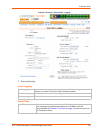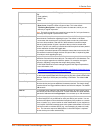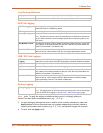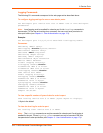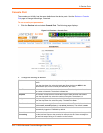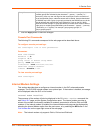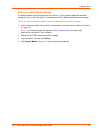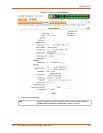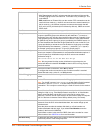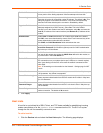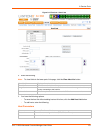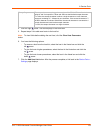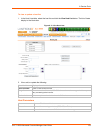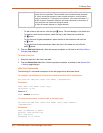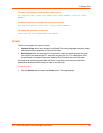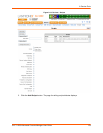
8: Device Ports
SLC™ 8000 Advanced Console Manager User Guide 129
Mode The format in which the data flows back and forth.
With Text selected, the SLC unit assumes that the modem will be used for
remotely logging into the command line. Text mode is only for dialing in. This
is the default.
PPP establishes an IP-based link over the modem. PPP connections can be
used in dial-out mode (e.g., the SLC unit connects to an external network) or
dial-in mode (e.g., the external computer connects to the network that the
SLC unit is part of), dial-back (dial-in followed by dial-out), CBCP server and
CBCP client.
Use Sites For more information see Sites (on page 149).
Group Access If undefined, any group can access the modem (text login only). If one or more
groups are specified (groups are delimited by the characters ',' (comma) or ';'
(semicolon)), then any user who logs into the modem must be a member of one
of the specified groups, otherwise access will be denied. Users authenticated
via RADIUS may have a group (or groups) provided by the RADIUS server via
the Filter-Id attribute that overrides the group defined for a user on the SLC unit.
A group provided by a remote server must be either a single group or multiple
groups delimited by the characters ',' (comma), ';' (semicolon), or '=' (equals) -
for example "group=group1,group2;" or "group1,group2,group3".
Initialization Script Commands sent to configure the modem may have up to 100 characters.
Consult your modem’s documentation for recommended initialization options. If
you do not specify an initialization script, the SLC uses a uses a default
initialization string of:
AT S7=45 SO=0 L1 V1 X4 &D2 &c1 E1 Q0
Note: We recommend that the modem initialization script always be pre-
pended with AT and include E1 V1 x4 Q0 so that the SLC unit may properly
control the modem.
Modem Timeout Timeout for modem connections. Set to No by default.
To configure the modem connection to time out when no traffic is received
choose Yes and enter a value of 1 to 9999 seconds.
Caller ID Logging Select to enable the SLC unit to log caller IDs on incoming calls. Disabled by
default.
Modem Command Modem AT command used to initiate caller ID logging by the modem.
Note: For the AT command, use
+VCID=1 to enable Caller ID with formatted
presentation, and use +VCID=2 to enable Caller ID with unformatted
presentation. This is subject to subscribing to a Caller ID service for the modem
line.
Check Dial Tone If set to Yes, the SLC will periodically check the modem for a dial tone while
waiting for a dial in (e.g., if the Modem State is set to Dial-in, or if the Modem
State is set to Dial-back and the SLC unit is in the Dial-in portion of the
sequence). The SLC unit can issue a trap or an event can be setup to notify the
user if no dial tone is detected. Set to Yes by default (every 15 minutes).
Dial-back Number Users with Dial-back can dial into the SLC unit and enter their login and
password. Once the SLC unit authenticates them, the modem hangs up and
dials them back .
Select the phone number the modem dials back on: a fixed number or a
number associated with their login. If you select Fixed Number, enter the
number (in the format 2123456789).
The dial-back number is also used for CBCP client as the number for a user-
defined number. See CBCP Server for more information.
Dial-back Delay For dial-back and CBCP Server, the number of seconds between the dial-in
and dial-out portions of the dialing sequence.



